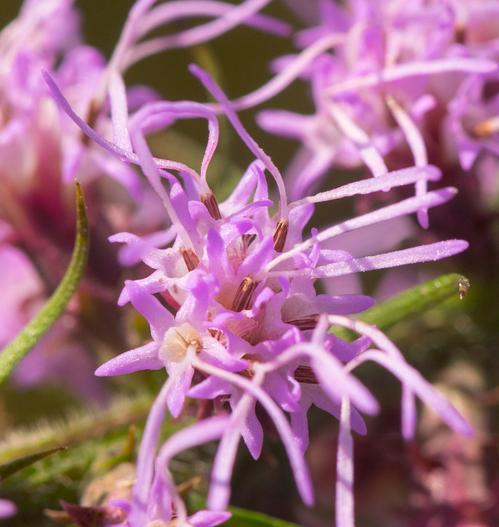Prairie Blazing Star
(Liatris pycnostachya)
Prairie Blazing Star (Liatris pycnostachya)
/
/

Joshua Mayer
CC BY-SA 2.0








































































Estimated Native Range
Summary
Prairie Blazing Star is valued for its showy flower spikes that add vertical interest to garden beds and borders. It is a popular choice for native plant gardens, prairie restorations, and as a cut flower due to its long vase life. This plant is particularly drought-tolerant once established, making it suitable for xeriscaping. It thrives in full sun and can adapt to a range of soil types, from well-drained to those with slower drainage. Gardeners should be aware that while Liatris pycnostachya is not prone to serious pest or disease problems, it can suffer from root rot in poorly drained soils. Additionally, it serves as an important nectar source for pollinators and is a larval host for the Bleeding Flower Moth (Schinia sanguinea).CC BY-SA 4.0
Plant Description
- Plant Type: Herb
- Height: 2-4 feet
- Width: 1-2 feet
- Growth Rate: Slow
- Flower Color: Pink, Purple
- Flowering Season: Summer
- Leaf Retention: Deciduous
Growth Requirements
- Sun: Full Sun
- Water: Medium
- Drainage: Fast, Medium, Slow
Common Uses
Bee Garden, Bird Garden, Border Plant, Butterfly Garden, Deer Resistant, Drought Tolerant, Fire Resistant, Hummingbird Garden, Low Maintenance, Rock Garden, Showy Flowers, Street Planting
Natural Habitat
Native to tallgrass prairies, open woods, and meadows of the central United States
Other Names
Common Names: Kansas Gayfeather , Cattail Gayfeather , Prairie Blazing-Star , Prairie Gayfeather , Thick-Spike Blazing-Star , Kansas Gay Feather , Liatris À Épi Dense , Cattail Blazing Star
Scientific Names: Liatris pycnostachya , Liatris bebbiana , Lacinaria pycnostachya , Liatris langloisii , Anonymos pilosus , Chrysocoma pilosa , Lacinaria langloisii , Lacinaria macilenta , Liatris brachystachya , Liatris hirsutissima
GBIF Accepted Name: Liatris pycnostachya Michx.